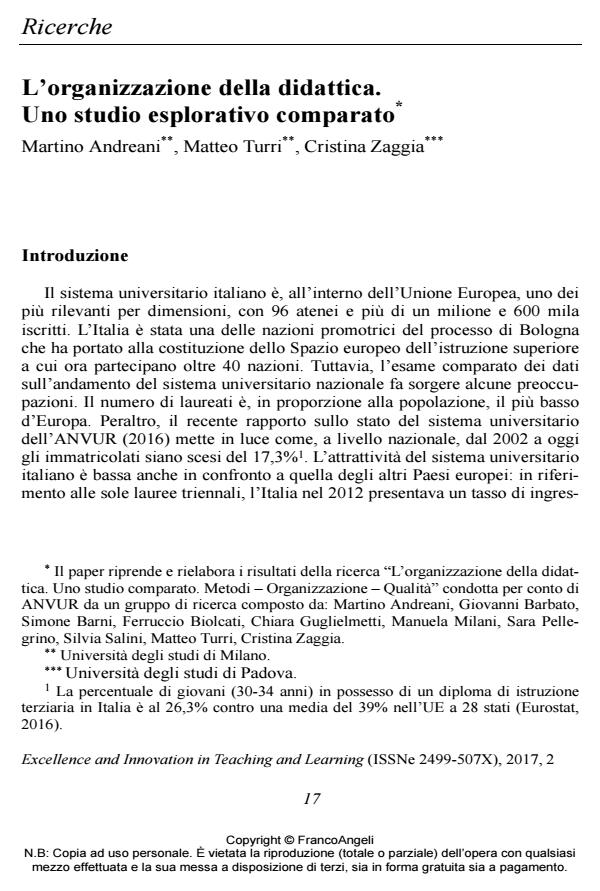Didactic organisation. An explorative study
Journal title EXCELLENCE AND INNOVATION IN LEARNING AND TEACHING
Author/s Martino Andreani, Matteo Turri, Cristina Zaggia
Publishing Year 2017 Issue 2017/2
Language Italian Pages 17 P. 17-33 File size 172 KB
DOI 10.3280/EXI2017-002002
DOI is like a bar code for intellectual property: to have more infomation
click here
Below, you can see the article first page
If you want to buy this article in PDF format, you can do it, following the instructions to buy download credits

FrancoAngeli is member of Publishers International Linking Association, Inc (PILA), a not-for-profit association which run the CrossRef service enabling links to and from online scholarly content.
OECD surveys show that students in Italy take longer to complete their higher education qualifications, access studies at a later stage, and have a high dropout rate. This paper outlines the main results of a study funded by ANVUR that involved 40 programme study coordinators from different countries (Italy, Switzerland and the UK).The programmes of study involved in the research concerned three fields: philosophy, management and chemistry. Each programme coordinator was interviewed about the organisation; the teaching, learning and assessment methods; and the quality assurance system of the respective undergraduate degrees. Compared with the other countries studied, and recognising the specificities of each discipline, the findings emphasise three critical aspects concerning the Italian way of organising, providing and evaluating the study programmes: the control of the students career; the learning assessment and the professional development of the teaching staff.
Keywords: Guidance; teaching, learning and assessment methods; quality assurance.
- ANVUR (2016). Rapporto biennale sullo stato del sistema universitario e della ricerca. Roma. Retrived from: http://www.anvur.org/attachments/article/1045/ANVUR_Rapporto_INTEGRALE_~.pdf.
- Baldacci, M. (2006). Ripensare il curricolo. Roma: Carocci.
- Barnett R. (2007). A Will to learn. Being a Student in an Age of Uncertainty. Buckingham (UK): Society for Research into Higher Education & OU Press.
- Biggs, J., & Tang, C. (2007). Teaching for Quality Learning at University. Buckingham (UK): Society for Research into Higher Education & OU Press, 3rd ed.
- Commissione Europea (2013). Report to the European Commission on Improving the Quality of Teaching and Learning in Europe’s Higher Education Institutions: Luxembourg.
- Creswell, J., & Plano, C.V. (2011). Designing and Conducting Mixed Methods Re-search. Thousand Oaks (CA)-London: Sage Publications, 2nd ed.
- Eisenhardt, K. (1989). Building Theories from Case-Study Research. Academy of Management Review, 144, 532-550.
- ENQUA (2015). Standards and Guidelines for Quality Assurance in the European Higher Education Area.
- EUA (2017), EUA’s Learning and Teaching Initiative. Report from the Thematic Peer Groups: Belgium.
- EUA (2015). Trends 2015: Learning and Teaching in European Universities: Belgium.
- Fattore, G. (2005). Metodi di ricerca in economia aziendale. Milano: Egea.
- Galliani, L. (2006). Questioni di valutazione istituzionale: prospettive di ateneo tra facoltà e corsi di studio, in Semeraro, R. (Eds.), Valutazione e qualità della didattica universitaria. Le prospettive nazionali e internazionali (pp. 97-134). Milano: FrancoAngeli.
- Hattie, J. (2012). Visible Learning for Teachers: Maximizing Impact on Learning. New York: Routledge.
- HEFCE (2015). Higher Education in England 2015, key facts: July 2015. Retrived from: http://www.hefce.ac.uk/.
- HESA (2015). Table A – HE Students by Level of Study and Mode of Study 2014/15. Retrived from: https://www.hesa.ac.uk/.
- Le Boterf, G. (1994). De la compétence. Essai sur un attracteur étrange. Paris: Edition d’Organisation.
- MIUR (2016). “Numero di studenti, iscritti e immatricolati nell’anno accademico 2014/2015 per ateneo e per genere”, MIUR-DGCASIS, Ufficio VI, Statistica e studi.
- Munari, A. (2003). Ricomporre psicologicamente le ragioni dell’educativo e del formativo. In Galliani, L. (a cura di), Educazione versus formazione. Napoli: Edizioni Scientifiche Italiane.
- OECD (2012). Fostering Quality Teaching in Higher Education: Policies and Practices. Institutional management in Higher Education. Paris: OECD Publishing.
- OECD (2013). Education at a Glance 2013: OECD Indicators. Paris: OECD Publishing. Retrived from: http://dx.doi.org/10.1787/eag-2013-en.
- OECD (2014). Education at a Glance 2014: OECD Indicators. Paris: OECD Publishing.
- Pettigrew, A. (1990). Longitudinal Field Research on Change, Theory, and Practice. Organization Science, 1, 267-292.
- Rebora, G. (a cura di) (2007). La crisi dei controlli. Imprese e istituzioni a confronto. Milano: Pearson Education.
- Royer, I., & Zarlowsky, P. (2001). Research Design. In Thietart, R.-A. (Eds.), Doing Management Research, A Comprehensive Guide (pp. 111-131). London: Sage Publications.
- Turri, M. (2011). L’università in transizione: governance, struttura economica e valutazione. Milano: Guerini Studio, vol. 1.
- Yin, R. (1994). Case Study Research: Design and Methods. Newbury Park (CA)-London: Sage Publications, 2nd ed.
- Zaggia, C. (2008). L'università delle competenze: progettazione e valutazione dei corsi di laurea nel processo di Bologna. Milano: FrancoAngeli.
- Zaggia, C. (2017). I centri e i servizi di supporto alla didattica nelle Università della Svizzera romanda. Scuola democratica, 3, 207-230.
Martino Andreani, Matteo Turri, Cristina Zaggia, L’organizzazione della didattica. Uno studio esplorativo comparato in "EXCELLENCE AND INNOVATION IN LEARNING AND TEACHING" 2/2017, pp 17-33, DOI: 10.3280/EXI2017-002002